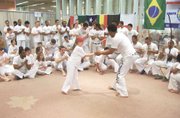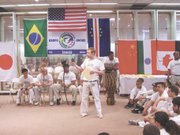<b>BASED ON HER</b> diminutive stature, few would guess that Mackenzie Hoffman is actually an accomplished martial artist.
<p>At nine years old, she’s just over 4 feet tall and weighs significantly less than a hundred pounds. But over the last four and a half years, the fourth grader at Stratford Landing Elementary School has become skilled at capoeira, a Brazilian folk tradition that mixes frenetic combat with fluid, almost balletic movements.
<p>“I like it because it’s not fighting,” Hoffman said. “It’s just dancing.”
<p>At a capoeira studio in Alexandria, she has risen to the rank of instructor and teaches her own classes. She also regularly competes against other adult instructors who are nearly twice her size.
<p>“It’s not that hard,” Hoffman said. “Sometimes you can go in between their legs.”
<p><b>CAPOEIRA</b> is gaining steam as a recreational activity in Northern Virginia.
<p>Studio Ondas, a capoeira group that operates out of the Landmark Mall, has been in the area for close to four years and has amassed a group of 40 students. It has also expanded to Arlington, where half a dozen more students practice unofficially.
<p>This month, Studio Ondas was host to a batizado ceremony that attracted dozens of capoeiristas from across the mid-Atlantic region.
<p>Literally translated from Portuguese, the word batizado means baptism. Batizado events are traditionally a sort of graduation ceremony used to induct new members into the fold and promote those who have made progress. But they are also used as a chance to socialize with fellow capoeiristas and show off one’s skills.
<p>“It’s kind of a celebration and kind of a party,” Studio Ondas owner and founder Kris Lanham said.
<p><b>SPRY AND ENERGETIC,</b> Lanham, 25, is also known as Doninha, a nickname he acquired after rising through the capoeira ranks. All accomplished capoeiristas have nicknames, a tradition that dates back to the early days of the sport.
<p>Capoeira was developed by slaves brought to Brazil from Africa in the 16th Century. After slavery was abolished in Brazil in the late 1800’s, the sport was outlawed for fear that it was tied to anti-government and gang activities.
<p>Capoeiristas were forced to move underground and hide their identities. The sport was eventually legalized and embraced but the use of aliases still persists.
<p>Hoffman is known as Abelha, or “The Bee.” Her mother, Marina, said that getting involved in capoeira has been a great pastime because “It gives her such a great feeling of self-achievement and self-esteem.” She also said that her daughter is learning to speak Portuguese and hopes to travel to Brazil someday.
<p>Rebecca Valois’s two teenagers are both involved in capoeira at Studio Ondas. Despite having to drive long distances from their home in Centreville, Valois is thrilled that her children are so enthusiastic about the program.
<p>“It gives them focus and motivation each week,” she said. “I think that’s awesome.”
<p><b>WHILE THE SPORT</b> can be challenging for even the most nimble of athletes, it is also remarkably child-friendly. The rules of capoeira emphasize playful sparring and improvisatory, expressive movements rather than hand to hand combat.
<p>“It’s not something that’s like other martial arts,” Lanham said. “It’s not about rote memorization. It’s about expression and the music. For kids who can’t pay attention very easily, it’s a nice way to keep them motivated.”
<p>At last week’s batizado, the capoeiristas gathered in a semi-circle around a group of musicians playing a steady rhythm on a conga, a tambourine and three berimbaus – traditional Brazilian string instruments.
<p>In groups of two or three at a time, the capoeiristas entered the middle of the circle, known as a roda, and competed against each other for 30 to 40 seconds or until someone tapped their shoulder to join in.
<p>While sweeping kicks were thrown at a furious pace, the capoeiristas rarely struck their partners. Despite the speed and intensity of the sparring matches, the capoeiristas were consistently jovial during the high-energy competitions. “It’s really fun,” Hoffman said after completing a full back flip and doing numerous hand stands.
<p>Now that his capoeira group is fully established in the community, Lanham, a graduate of Hayfield High School, said that his goal for Studio Ondas is to take it to new places and new people.
<p>“Capoeira is starting to pop up all over the place,” he said. “What we’re going to do is try to bring it to the streets and get as many people to get a taste for capoeira and see if it’s something they want to do.”



